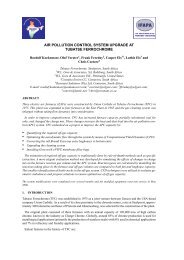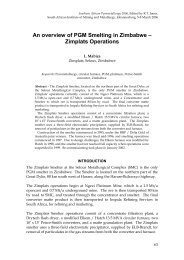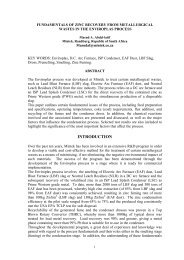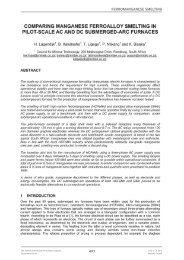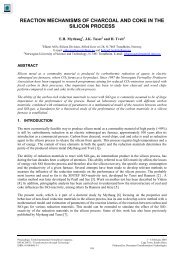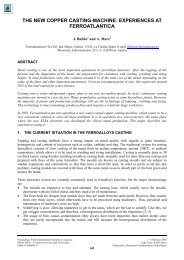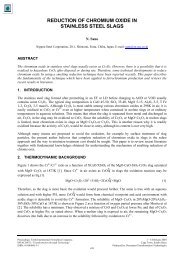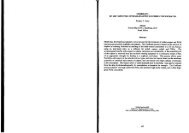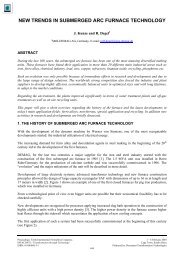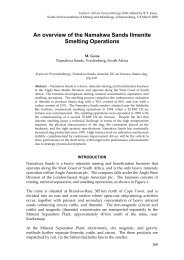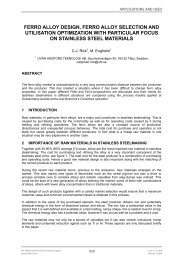chromium in submerged-arc furnace - Pyro.co.za
chromium in submerged-arc furnace - Pyro.co.za
chromium in submerged-arc furnace - Pyro.co.za
- No tags were found...
You also want an ePaper? Increase the reach of your titles
YUMPU automatically turns print PDFs into web optimized ePapers that Google loves.
Ferro<strong>chromium</strong> Production3 TEMPERATURE PROFILE MODEL AND SIMULATION3.1 S<strong>co</strong>peOptimum temperature profile of the <strong>furnace</strong> is crucial for the successful operation of the process.Temperatures at the hearth and tap hole region must be above the liquidus temperature of the metaland that of the slag so that these liquids do not freeze and tapp<strong>in</strong>g is smooth. The temperaturedistribution must be symmetric <strong>in</strong> the <strong>furnace</strong> along the radial direction. The top of the charge bedmust be at an optimum temperature so that the heat loss through radiation and <strong>co</strong>nvection ism<strong>in</strong>imized. The heat carried away by the top gas also should be m<strong>in</strong>imum. The temperaturedistribution must be such that the charge gets adequate time to get reduced as it travels down the<strong>furnace</strong> to the hearth region. This will have an impact on the schedul<strong>in</strong>g of metal tapp<strong>in</strong>g formaximis<strong>in</strong>g efficiency of operation. The ‘Temperature Profile’ Module must be capable of provid<strong>in</strong>g thefollow<strong>in</strong>g crucial <strong>in</strong>formation: (1) Temperature of the metal and slag at the hearth level: (2)Temperature at the slag port; (3) Size of the high temperature zone: (4) Sizes of various temperaturezones: (5) Temperature at the op of the charge bed: (6) Temperature along the walls3.2 Factors Influenc<strong>in</strong>g the Temperature ProfileThe follow<strong>in</strong>g factors <strong>in</strong>fluence the temperature profile <strong>in</strong>side the <strong>furnace</strong>:1. Heat generation through ohmic heat<strong>in</strong>g <strong>in</strong> the various zones2. Temperature at the electrodes3. Heat capacities of charge materials, metal, slag.4. Thermal <strong>co</strong>nductivity of charge materials5. Heat requirement for reduction reactions and melt<strong>in</strong>g6. Porosity of the bed which is <strong>in</strong>fluenced by the particle size, shape etc.7. Quantity of gas generated and its heat capacity8. Thermal <strong>co</strong>nductivity of refractory9. Heat loss through radiation at the top of the charge bedThe modell<strong>in</strong>g of the temperature profile <strong>in</strong> the <strong>submerged</strong>-<strong>arc</strong> <strong>furnace</strong> has been already discussed <strong>in</strong>detail elsewhere[14]3.3 Us<strong>in</strong>g the Module <strong>in</strong> Industrial OperationThis module is a highly valuable tool for understand<strong>in</strong>g the operation and <strong>co</strong>ntroll<strong>in</strong>g it.1. Comb<strong>in</strong>ed with the module on ‘reduction k<strong>in</strong>etics’, this module will give an estimate ofthe time required for the <strong>co</strong>mplete reduction of <strong>chromium</strong> and iron. This can be used forschedul<strong>in</strong>g the tapp<strong>in</strong>g of metal and slag.2. The module can be used for adjust<strong>in</strong>g factors such as bed porosity to generate an idealtemperature profile that can m<strong>in</strong>imise the heat loss through the walls.3. This module will give an estimate of the high temperature zone. This can be <strong>co</strong>ntrolledthrough appropriate modification <strong>in</strong> operation practice, such as applied voltage, chargedistribution on the top of the bed etc.4. This module will serve to explore the <strong>in</strong>fluence of altered charge distribution on the top ofthe bed and develop new operation practices.5. This module can be used for <strong>co</strong>ntroll<strong>in</strong>g the temperature of the top gas and reduce theloss through this.Figure 2 gives a typical temperature profile <strong>in</strong> a <strong>submerged</strong>-<strong>arc</strong> <strong>furnace</strong>.The Twelfth International Ferroalloys CongressSusta<strong>in</strong>able Future404June 6 – 9, 2010Hels<strong>in</strong>ki, F<strong>in</strong>land



